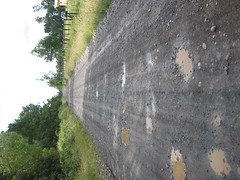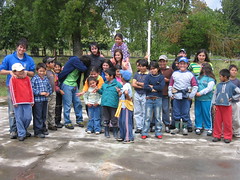More about Missions
20 January 2006
6:31 PM
Missions are something very common in Chile and uncommon in the U.S., so I should explain. During summer vacation (December, January, February) high school students go to towns throughout Chile on mission trips. A typical trip lasts one to two weeks. While there, the students go door to door visiting families, organize games for children, celebrate Mass, and have youth groups at night. The philosophy behind the trips is called “re-evangelization.” Chile’s population is largely Catholic, so these trips don’t focus on conversion even when students encounter non-Catholics. The goal is to build and reinforce communities.
Our mission trip with Saint George, a preschool through 12th grade school in Santiago run by Holy Cross, started January 2 with our 14-hour bus ride to Osorno in southern Chile. Around 80 students went on our trip, plus some teachers and recent alumni. The day after we arrived, we split into four different groups of 15-25 people. Each went to a surrounding rural village. My group of 16 went to San Florentino, a town in the country where cows greatly outnumber residents.
When we arrived I was surprised that all the high school students went right to work cleaning the schoolhouse where we would stay. Though there was some balking at cleaning the bathroom, all the students were enthusiastic about mopping, scrubbing, and generally removing layers of dust from everything. Before long, our kitchen was clean, our pantry was stocked, and our bedroom was populated with a dozen sleeping bags.

Every morning, after our 7:30am wake up, we ate breakfast and split into five groups of three to four people. One group was in charge of the house, which included cleaning and cooking. Each of the other four groups went to a certain geographic region of the town and visiting people’s houses, going door to door. San Florentino is sparsely populated, though spread out over lots of farmland. Our geographic divisions went something like this: up the street and on the left, up the street on the right, down the street on the left, and down the street on the right. The aforementioned street is shown in the picture to the right.
During a typical house visit we would enter a family’s house and talk with them. Though the conversations often included a fair amount of small talk, I found people eager to talk with us. Often they would tell us about things that had happened in the past year, how life and business were going, and things of that nature. We invited the families to our events for the day, which included games for children from 3:30pm to 6:00pm, Mass at 7:00pm, and a youth group at 9:00pm. If the people were interested, we said a prayer or discussed the reading of the day. At first I was a little uncomfortable with visiting people’s houses, but they were almost always very welcoming and happy that we were in town. Many people offered us coffee or tea, cheese fresh from their cows, or lunch. I think the warm welcome has something to do with how common missions are in Chile and also the fact that people are already part of the church community. In fact, most took us up on our offers by sending their kids in the afternoon and attending Mass.
Playing games with the kids in the afternoon was a blast. We did crafts, played soccer and dodge ball, and did dinamicas. I think the best translation for dinamica would be something like “ice breaker,” but it is really a broad category and the kids are nuts for dinamicas here in Chile. Some of them involve singing songs, others involve repeating chants after a leader, doing dances, or running around. Often it’s a combination. Here’s one example: one person runs around singing the following song (translated):
I’m Mr. Ducky. You’re Mrs. Ducky.
You got to swim swim swim without rest!
Searching for fishies,
with pretty colors,
to eat them all yourself.
Then the leader stops in front of a single person in the circle and does a quacking dance. That person joins the song and dance and it keeps going until everyone is a duck and searching for fishies. Since each person who is a duck picks another person to be a duck, people become ducks at literally an exponential rate (2^0 the first time, then 2^1, 2^2, and so on). I don’t think the kids think about that, though.
At 6:45 we made our way to the local chapel for Mass. Although many people don’t find church services particularly exciting, we had people people come each day. Such is the shortage of clergymen in the area that the people in San Florentino that they last had Mass in October—three months ago.
After Mass we performed a short children’s theater, often with lessons from the reading for the day. I was relegated to playing farm animals for the most part (dogs, cows, water buffalo, and the like), which may have had something to do with my gringo-ness. One time when the theater director had a lot of confidence in me I played a Frenchman who sees a poor peasant and decides to help. I have written about my inability to make jokes in Spanish, but I think some people split a gut listening to me trying to speak Spanish with a French accent. Plus I had a beret, which is always good for a laugh.
At 9:00pm we had a youth group meeting for teenagers in the community. We played more grown-up dinamicas that lawyers would have banished from the U.S. about 45 seconds after their introduction. Here’s an example: every person gets a match; people in the circle then take turns lighting their matches and trying to come up with as many words beginning with a certain (random) letter as possible before the match burns out. It has lawsuit stamped all over it.
Finally, after dinner (usually at 10:00pm, though twice after midnight), we would do an evaluation of the day and get to bed by 1:00am. Or maybe 2:00am. These high school kids are too late-night for me. At least when you consider that we followed the 7:30am to 2:00am routine that I have just described for about 12 straight days. When people complained about fatigue, I wanted to explain the basic connection between fatigue and sleep. Back when I was a college student (circa last year), I might stay up until 5:00am working on a paper, but I sure didn’t expect to be bright-eyed and bushy-tailed the next day.
The trip overall was really an enjoyable experience, though trying at times. For one, the weather in Osorno was nothing like that near Santiago these days. Although it is summer, we had rain and cold on a daily basis. Though my Spanish is improving, I often had trouble understanding the high school students from St. George. And some mornings, we would walk for four to five hours without visiting hardly any houses because they were pretty spread out. When we returned on January 13, I was happy to be back in my house.
I should add that I was pretty impressed with the St. George student’s moxie. They were active and motivated about the whole experience. I spoke with the school’s director and discovered that about 400 of the 800 students in the high school participate in various service-oriented project during the summer. That included summer day-camps in the less privileged neighborhoods in Santiago, constructing houses, a scout program, and, of course, missions.


Comments